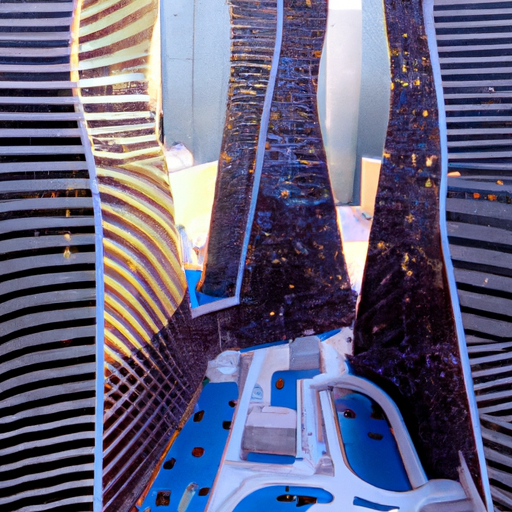Revolutionizing Architectural Design: AI’s Impact on the Industry
The role of artificial intelligence (AI) in architectural design is rapidly evolving, revolutionizing the industry and transforming the way architects approach their work. As AI continues to advance, it is becoming an increasingly valuable tool for architects, enabling them to create more innovative, efficient, and sustainable designs. This article will explore the various ways in which AI is impacting the architectural design process, from conceptualization to construction, and discuss the potential benefits and challenges that this technology presents for the industry.
One of the most significant ways in which AI is revolutionizing architectural design is through the use of generative design tools. These tools utilize algorithms to generate a vast array of design options based on specific input parameters, such as site constraints, building codes, and desired performance outcomes. By automating the initial stages of the design process, generative design allows architects to explore a multitude of design possibilities in a fraction of the time it would take using traditional methods. This not only increases efficiency but also enables architects to discover innovative solutions that may not have been considered otherwise.
In addition to generative design, AI is also being used to optimize building performance and sustainability. Machine learning algorithms can analyze vast amounts of data to identify patterns and trends, allowing architects to make more informed decisions about materials, building systems, and energy use. For example, AI can be used to predict the performance of different building materials in various climates, helping architects select the most appropriate materials for a specific project. Similarly, AI can be used to optimize the design of building systems, such as heating, ventilation, and air conditioning (HVAC), to minimize energy consumption and reduce the building’s environmental impact.
Another area where AI is having a significant impact on architectural design is in the realm of building information modeling (BIM). BIM is a digital representation of a building’s physical and functional characteristics, which can be used to facilitate the design, construction, and operation of the building. AI can be integrated with BIM to automate various aspects of the design process, such as code compliance checking and clash detection. This not only streamlines the design process but also helps to reduce errors and improve overall design quality.
AI is also playing a role in the construction phase of architectural projects. Robotics and automation technologies are being used to perform tasks such as bricklaying, concrete pouring, and steel fabrication, which can help to increase efficiency and reduce construction time. Furthermore, AI can be used to monitor construction progress and identify potential issues before they become critical, helping to minimize delays and cost overruns.
While the potential benefits of AI in architectural design are significant, there are also challenges and concerns that need to be addressed. One of the primary concerns is the potential loss of jobs due to increased automation. As AI continues to advance, it is possible that some tasks traditionally performed by architects and other design professionals could be automated, leading to job displacement. However, it is also worth noting that AI has the potential to create new job opportunities in areas such as data analysis and software development.
Another challenge is the ethical implications of using AI in architectural design. As AI becomes more integrated into the design process, it is essential to ensure that the technology is used responsibly and ethically. This includes addressing issues such as data privacy, algorithmic bias, and the potential for AI to perpetuate existing inequalities in the built environment.
In conclusion, AI is poised to have a profound impact on the architectural design industry, offering the potential for increased efficiency, innovation, and sustainability. However, it is crucial for architects and other industry professionals to carefully consider the potential challenges and ethical implications of this technology as they continue to integrate AI into their work. By doing so, they can harness the power of AI to create a built environment that is not only more efficient and sustainable but also more equitable and inclusive.
AI-Driven Design: Transforming the Architectural Process

The role of artificial intelligence (AI) in architectural design is rapidly evolving, transforming the way architects approach their work and the built environment. As AI-driven design tools become more sophisticated and accessible, architects are increasingly leveraging these technologies to enhance their creative process, optimize building performance, and improve the overall quality of their designs. This transformation is not only reshaping the architectural profession but also has the potential to significantly impact the way we design, construct, and inhabit our built environment.
One of the most significant ways AI is transforming the architectural process is through the use of generative design. Generative design is an iterative process that uses algorithms to explore a vast number of design possibilities based on a set of predefined constraints and objectives. By inputting specific design parameters, such as site conditions, building codes, and performance requirements, architects can harness the power of AI to generate thousands of design options that meet these criteria. This enables architects to quickly explore a wide range of design alternatives, identify optimal solutions, and make more informed decisions throughout the design process.
In addition to generative design, AI-driven tools are also being used to optimize building performance and sustainability. By analyzing vast amounts of data, AI algorithms can identify patterns and relationships that may not be readily apparent to human designers. This can help architects make more informed decisions about building orientation, envelope design, and material selection, ultimately leading to more energy-efficient and environmentally friendly buildings. For example, AI-driven energy modeling tools can predict a building’s energy consumption based on various design parameters, allowing architects to make data-driven decisions that minimize energy use and reduce the building’s carbon footprint.
Another area where AI is having a significant impact on architectural design is in the realm of building information modeling (BIM). BIM is a digital representation of a building’s physical and functional characteristics, which can be used to facilitate collaboration and streamline the design and construction process. AI-driven BIM tools can automatically generate and update building components, such as walls, floors, and roofs, based on design changes, saving architects time and reducing the potential for errors. Additionally, AI algorithms can analyze BIM data to identify potential design conflicts or inefficiencies, helping architects to address these issues early in the design process and avoid costly changes during construction.
AI is also transforming the way architects engage with clients and stakeholders. Virtual reality (VR) and augmented reality (AR) technologies, powered by AI, are enabling architects to create immersive, interactive design experiences that allow clients to better understand and visualize proposed designs. By combining AI-driven design tools with VR and AR technologies, architects can create more engaging and effective presentations, helping to facilitate communication and collaboration throughout the design process.
While the integration of AI into architectural design is still in its early stages, the potential benefits are immense. As AI-driven design tools continue to evolve and become more widely adopted, architects will be better equipped to navigate the complex challenges of the built environment, creating more innovative, sustainable, and efficient buildings. However, it is important to recognize that AI is not a replacement for human creativity and intuition. Rather, it is a powerful tool that can augment and enhance the architect’s creative process, allowing them to focus on what they do best: designing inspiring and functional spaces that enrich our lives and communities.
In conclusion, the role of AI in architectural design is transformative, offering new possibilities for architects to explore and optimize their designs. From generative design and building performance optimization to BIM and immersive client experiences, AI-driven tools are reshaping the architectural process and the built environment. As these technologies continue to advance, architects must embrace the potential of AI to enhance their creative process and deliver more innovative, sustainable, and efficient buildings for the future.
The Future of Sustainable Architecture: AI’s Role in Energy-Efficient Design
The role of artificial intelligence (AI) in architectural design is rapidly evolving, with the potential to revolutionize the way we approach sustainable architecture. As the world grapples with the challenges of climate change and resource depletion, the need for energy-efficient design has never been more pressing. AI has the potential to play a crucial role in addressing these challenges by enabling architects to create more sustainable, energy-efficient buildings that minimize their environmental impact.
One of the most significant ways AI can contribute to sustainable architecture is through the optimization of building performance. By analyzing vast amounts of data, AI algorithms can identify patterns and trends that human designers might overlook, allowing them to make more informed decisions about building materials, construction techniques, and energy systems. This can lead to significant reductions in energy consumption, as well as improvements in occupant comfort and well-being.
For example, AI can be used to optimize the design of a building’s envelope – the physical barrier between the interior and exterior environments. By analyzing factors such as solar radiation, wind patterns, and local climate conditions, AI algorithms can help architects determine the most effective combination of insulation, glazing, and shading devices to minimize heat gain and loss. This can result in significant energy savings, as well as a more comfortable indoor environment for occupants.
AI can also play a role in the design of a building’s mechanical and electrical systems, which are responsible for providing heating, cooling, and lighting. By analyzing data on occupant behavior, energy consumption, and equipment performance, AI algorithms can help architects and engineers design more efficient systems that better meet the needs of building occupants. This can lead to further reductions in energy consumption, as well as improvements in occupant comfort and productivity.
Another area where AI can contribute to sustainable architecture is in the realm of building simulation and analysis. Traditionally, architects have relied on static computer models to predict the performance of their designs, often with limited accuracy. AI has the potential to revolutionize this process by enabling the creation of dynamic, real-time simulations that can more accurately predict how a building will perform under various conditions. This can help architects identify potential issues and make adjustments to their designs before construction begins, ultimately resulting in more energy-efficient buildings.
In addition to optimizing building performance, AI can also play a role in the broader context of sustainable urban planning. By analyzing data on factors such as population growth, land use, and transportation patterns, AI algorithms can help city planners make more informed decisions about the allocation of resources and the development of infrastructure. This can lead to more sustainable, livable cities that are better equipped to meet the challenges of the future.
Despite its potential benefits, the integration of AI into architectural design is not without its challenges. One of the primary concerns is the potential loss of human creativity and intuition in the design process, as architects increasingly rely on algorithms to make decisions. However, many experts argue that AI should be viewed as a tool that can augment and enhance human creativity, rather than replace it.
In conclusion, the role of AI in architectural design is poised to have a significant impact on the future of sustainable architecture. By enabling architects to create more energy-efficient buildings and urban environments, AI has the potential to play a crucial role in addressing the challenges of climate change and resource depletion. As the technology continues to evolve, it will be essential for architects and designers to embrace AI as a tool for innovation and collaboration, rather than a threat to their profession.
Q&A
Question 1: How does AI contribute to the architectural design process?
Answer 1: AI contributes to the architectural design process by automating repetitive tasks, optimizing designs for energy efficiency and structural integrity, generating design variations based on specific parameters, and assisting in decision-making through data analysis and predictive modeling.
Question 2: What are some specific AI tools used in architectural design?
Answer 2: Some specific AI tools used in architectural design include generative design software, parametric modeling tools, building information modeling (BIM) systems, and machine learning algorithms for analyzing and predicting building performance.
Question 3: How can AI improve sustainability in architectural design?
Answer 3: AI can improve sustainability in architectural design by optimizing building layouts for energy efficiency, reducing material waste through precise calculations, simulating and predicting building performance to minimize environmental impact, and facilitating the integration of renewable energy systems and smart building technologies.
Conclusion
In conclusion, the role of AI in architectural design is transformative, as it enhances the design process, optimizes resource utilization, and fosters innovation. By automating repetitive tasks, enabling data-driven decision-making, and facilitating collaboration, AI empowers architects to create more sustainable, efficient, and aesthetically appealing structures. As AI technology continues to evolve, its integration into architectural design will further revolutionize the industry, pushing the boundaries of what is possible in the built environment.


